
|

|
La réunion annuelle conjointe de 2023 se tiendra à Saskatoon, en Saskatchewan, du 15 au 18 octobre 2023, et sera organisée par la Société d’entomologie de Saskatchewan.
De plus amples informations sur le thème et le lieu de la réunion seront bientôt publiées.
 Outsiders and Others est à la recherche d’artistes visuels du Canada et des États-Unis dont les œuvres sont axées sur les insectes xylophages, le bois et/ou la relation entre les insectes xylophages et le bois.
Outsiders and Others est à la recherche d’artistes visuels du Canada et des États-Unis dont les œuvres sont axées sur les insectes xylophages, le bois et/ou la relation entre les insectes xylophages et le bois.
Cette exposition est présentée en même temps que la réunion conjointe des sociétés américaine et canadienne d’entomologie, à Vancouver, du 13 au 16 novembre 2022.
Comment appliquer par courriel :
Envoyez vos informations par courriel à : outsidersandothers@gmail.com et inscrivez « Boring Art » comme objet. Les artistes seront informés par courriel des résultats de la sélection avant le 7 octobre.
Autres informations:
Outsiders and Others est une société artistique à but non lucratif dont l’objectif est de mettre en avant les artistes non traditionnels. Cela inclut les artistes marginaux, folkloriques, autodidactes, visionnaires, intuitifs et les artistes en situation de handicap.
Notre galerie est située au 716 East Hastings Street à Vancouver et est ouverte au public du mercredi au samedi de 11h à 16h et sur rendez-vous. Nous avons également une galerie en vitrine au #100-938 Howe Street.
Des questions? N’hésitez pas à contacter le Directeur/Conservateur Yuri Arajs à outsidersandothers@gmail.com ou à nous visiter en ligne à www.outsidersandothers.com.

 Le 8 juin, nous vous invitons à célébrer la Journée Nationale des Insectes (JNI) en compagnie de milliers d’amateurs, de professionnels et d’amoureux des insectes à travers le Canada. Nous vous invitons à participer au « défi photo d’insecte » sur les réseaux sociaux. Cette année, nous convions les entomologistes professionnels à «levez le petit doigt pour les insectes» en partageant avec le public leur amour des insectes et des arthropodes sur les réseaux sociaux en prenant une photo ou un vidéo de leur sujet d’étude dans leur main ou sur leur doigt. Partagez votre amour des insectes!
Le 8 juin, nous vous invitons à célébrer la Journée Nationale des Insectes (JNI) en compagnie de milliers d’amateurs, de professionnels et d’amoureux des insectes à travers le Canada. Nous vous invitons à participer au « défi photo d’insecte » sur les réseaux sociaux. Cette année, nous convions les entomologistes professionnels à «levez le petit doigt pour les insectes» en partageant avec le public leur amour des insectes et des arthropodes sur les réseaux sociaux en prenant une photo ou un vidéo de leur sujet d’étude dans leur main ou sur leur doigt. Partagez votre amour des insectes!
Afin de participer au défi, une personne devra publier au moins une photo d’insecte lors de la Journée Nationale des Insectes le 8 juin prochain. Dans la publication, la personne devra ajouter les mots-clics qui y sont associés et nominer cinq de ses amis en les invitant à publier une photo d’insecte à leur tour.
Mots-clics : #DéfiPhotoInsecte #JournéeNationaleInsectes
Comment fonctionne un mot-clic : Un mot-clic est un lien qui rend possible pour les autres usagers de trouver facilement des messages ou des publications avec un thème ou un contenu. Vous pouvez simplement utiliser le mot-clic sur les médias sociaux (Facebook, Instagram ou Twitter) en vous assurant que votre publication soit publique.
Pour plus d’information, et pour télécharger le matériel promotionnel, allez à l’adresse suivante: https://esc-sec.ca/fr/entomology-resources/jni-journee-nationale-des-insects/
Sponsorisé par la Société d’Entomologie du Canada (https://esc-sec.ca/)
Bonjour aux membres étudiants de la SEC! Le conseil d’administration de la SEC a annoncé la disponibilité de 15 bourses de voyage Ed Becker d’une valeur de 500$ chacune pour permettre aux étudiants de se rendre à la réunion annuelle conjointe 2022 et de présenter une conférence ou une affiche dans la magnifique ville de Vancouver, en Colombie-Britannique, dans le centre de congrès surplombant le port. Les observations de phoques et de goélands sont presque garanties depuis les fenêtres de la salle de conférence. Un grand merci à la Fondation Dufault pour son généreux don qui nous permet de soutenir davantage les déplacements des étudiants à nos réunions.
Alors que les soumissions de résumés pour la réunion annuelle conjointe de 2022 en Colombie-Britannique sont en cours, l’appel à candidatures pour les bourses Ed Becker pour la réunion annuelle est également ouvert et la date limite de soumission est fixée au 3 juin 2022. Toutes les informations nécessaires pour structurer votre candidature se trouvent sur la page web de la SEC, sous la rubrique « Bourses d’études », et plus précisément à l’adresse suivante : https://esc-sec.ca/fr/students/student-awards/#toggle-id-9
Les candidatures doivent être envoyées par courriel à la coordination de l’association de la SEC à l’adresse info@esc-sec.ca en indiquant dans l’objet votre nom de famille et le nom du prix avant la date limite du 3 juin 2022.
Entomologiquement vôtre,
Tyler Wist: président du comité des prix étudiants de la SEC
 Venez en grand nombre virtuellement pour le congrès conjoint de la Société d’entomolgie du Canada et de la Société Entomologique de l’Ontario
Venez en grand nombre virtuellement pour le congrès conjoint de la Société d’entomolgie du Canada et de la Société Entomologique de l’Ontario
Date : du 15 au 18 novembre 2021
Lieu : La réunion virtuelle sera hébergée par Showcare. Un site Web dédié a la réunion virtuelle sera annoncé a l’automne.
Dates à retenir :
• Début d’inscription — 5 juin
• Date limite de préinscription — 9 août
• Date limite pour les soumissions de présentation — 13 septembre
Pour plus d’informations sur le thème de la réunion, les conférenciers et les symposiums prevus : https://www.entsocont.ca/esceso-2021-rac-franccedilais.html
Nous espérons vous voir virtuellement à l’automne!
lnscrivez-vous maintenant!
 Le 8 juin, nous vous invitons à célébrer la Journée Nationale des Insectes (JNI) en compagnie de milliers d’amateurs, de professionnels et d’amoureux des insectes à travers le Canada. Cette année, en raison des restrictions causées par le coronavirus SARS-CoV-2 (COVID-19), les activités auront lieux en ligne. Il sera donc possible de participer au « défi photo d’insecte » sur les réseaux sociaux. Ce défi vise à encourager le public à développer sa curiosité envers les insectes et à le sensibiliser à leur présence.
Le 8 juin, nous vous invitons à célébrer la Journée Nationale des Insectes (JNI) en compagnie de milliers d’amateurs, de professionnels et d’amoureux des insectes à travers le Canada. Cette année, en raison des restrictions causées par le coronavirus SARS-CoV-2 (COVID-19), les activités auront lieux en ligne. Il sera donc possible de participer au « défi photo d’insecte » sur les réseaux sociaux. Ce défi vise à encourager le public à développer sa curiosité envers les insectes et à le sensibiliser à leur présence.
Afin de participer au défi, une personne devra publier au moins une photo d’insecte lors de la Journée Nationale des Insectes le 8 juin prochain. Dans la publication, la personne devra ajouter les mots-clics qui y sont associés et nominer cinq de ses amis en les invitant à publier une photo d’insecte à leur tour.

#DéfiPhotoInsecte #JournéeNationaleInsectes
Un mot-clic est un lien qui rend possible pour les autres usagers de trouver facilement des messages ou des publications avec un thème ou un contenu. Vous pouvez simplement utiliser le mot-clic sur les médias sociaux (Facebook, Instagram ou Twitter) en vous assurant que votre publication soit publique.
https://esc-sec.ca/fr/entomology-resources/jni-journee-nationale-des-insects/
Sponsorisé par la Société d’Entomologie du Canada (https://esc-sec.ca/)

Ever wish you could travel back through time and see a west coast Vancouver Island rainforest before industrial logging? To see huge old trees, intact soils and life in a climax ecosystem? You do not have to invent a time machine, you only need to travel about an hour out of Port Renfrew to the spectacular Walbran Valley.
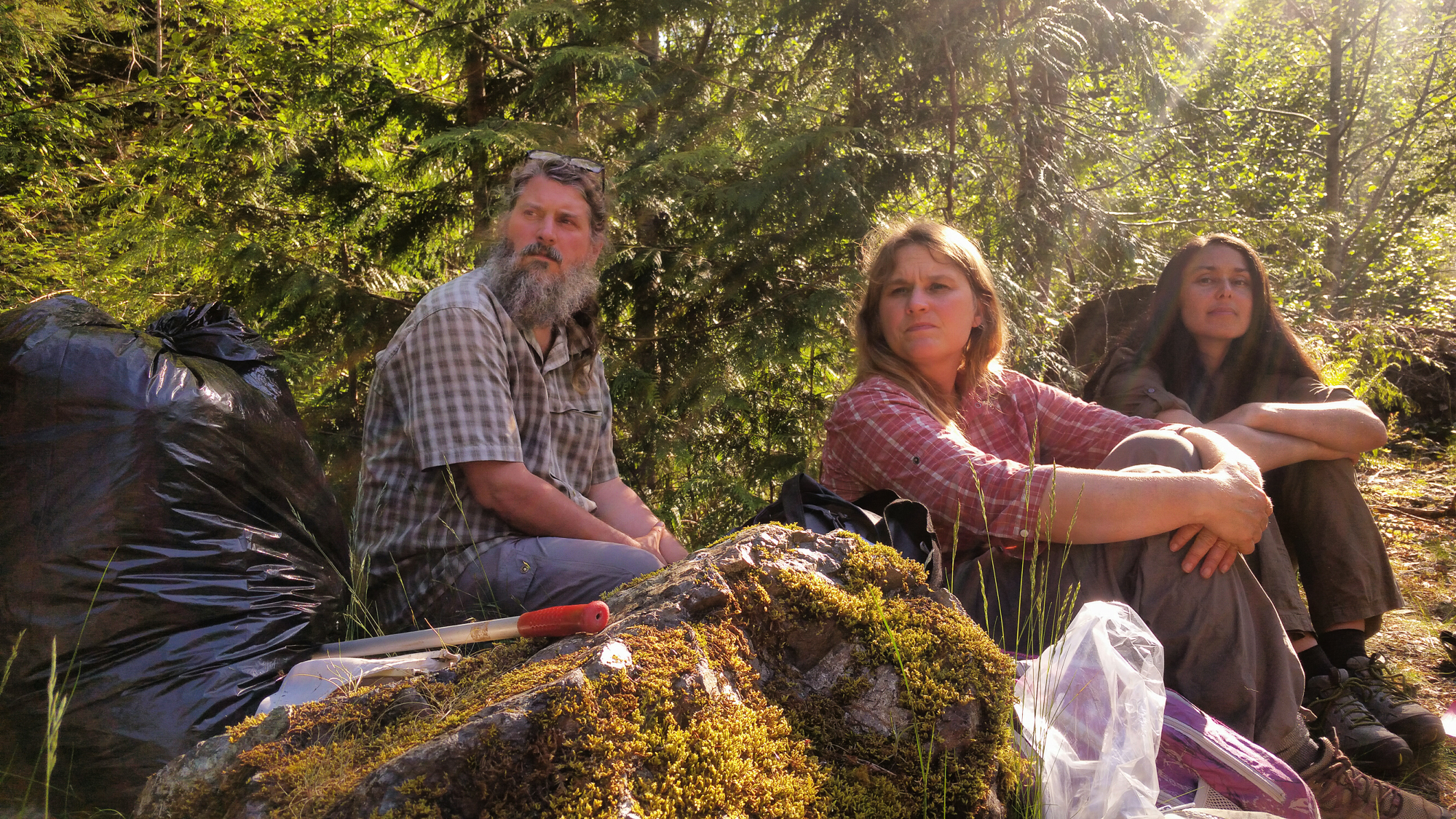
As part of an effort to document the biodiversity of the valley, I traveled with fellow arachnologists Claudia Copley, Darren Copley, Zoe Lindo, and Catherine Scott, along with birders, mycologists, lichenologists and assorted volunteers to spend a day among the giant trees. We were there at the invitation of the Friends of Carmanah-Walbran to lend our expertise to the effort of catloguing the biodiversity of this beautiful, yet still at-risk west coast habitat.
We arrived at the somewhat storied “Bridge to Nowhere”, where in 1991 environmental protesters confronted the logging companies, the RCMP and the government of British Columbia, holding the line against industrial exploitation of a rare ecosystem. What the activists were asking for seems modest: Can’t we have just this one watershed, among all the others on Vancouver Island, be preserved and protected from the clearcutting and degradation that is the fate of every other valley on the Island?
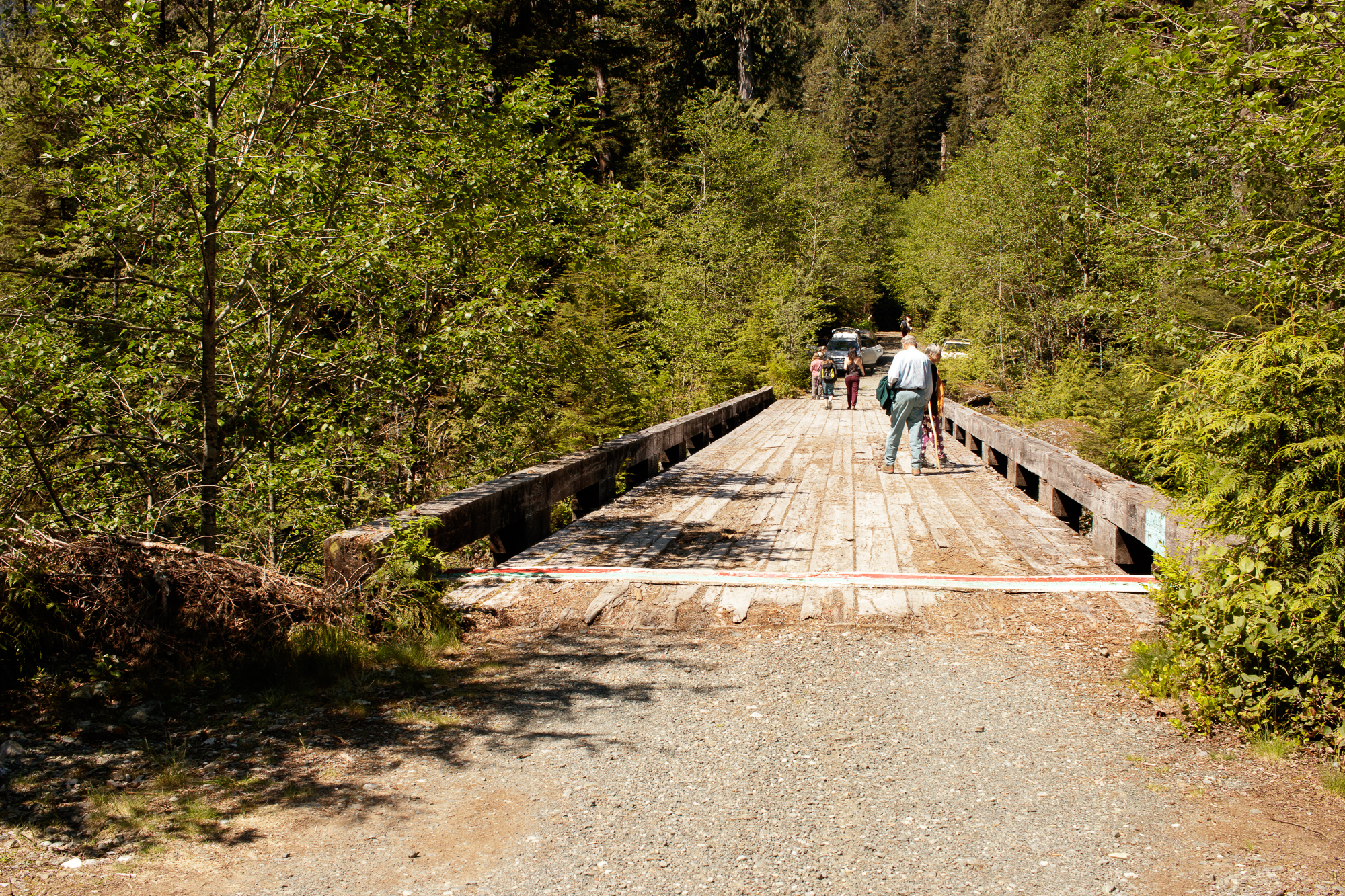 2. Pacheedaht elder Bill Jones walks across the Bridge to Nowhere
2. Pacheedaht elder Bill Jones walks across the Bridge to NowhereWhile the Friends of Carmanah-Walbran took the other participants deep into the woods on hikes, we arachnologists ventured only short distances into the woods, as our slow and careful sifting through the soil and beating of the bushes is certainly not a thrill ride for everyone. For us, however, it was thrilling, as within 30 minutes of arrival on site, we had found a beautiful and seemingly dense population of Hexura picea, a relative of tarantulas.
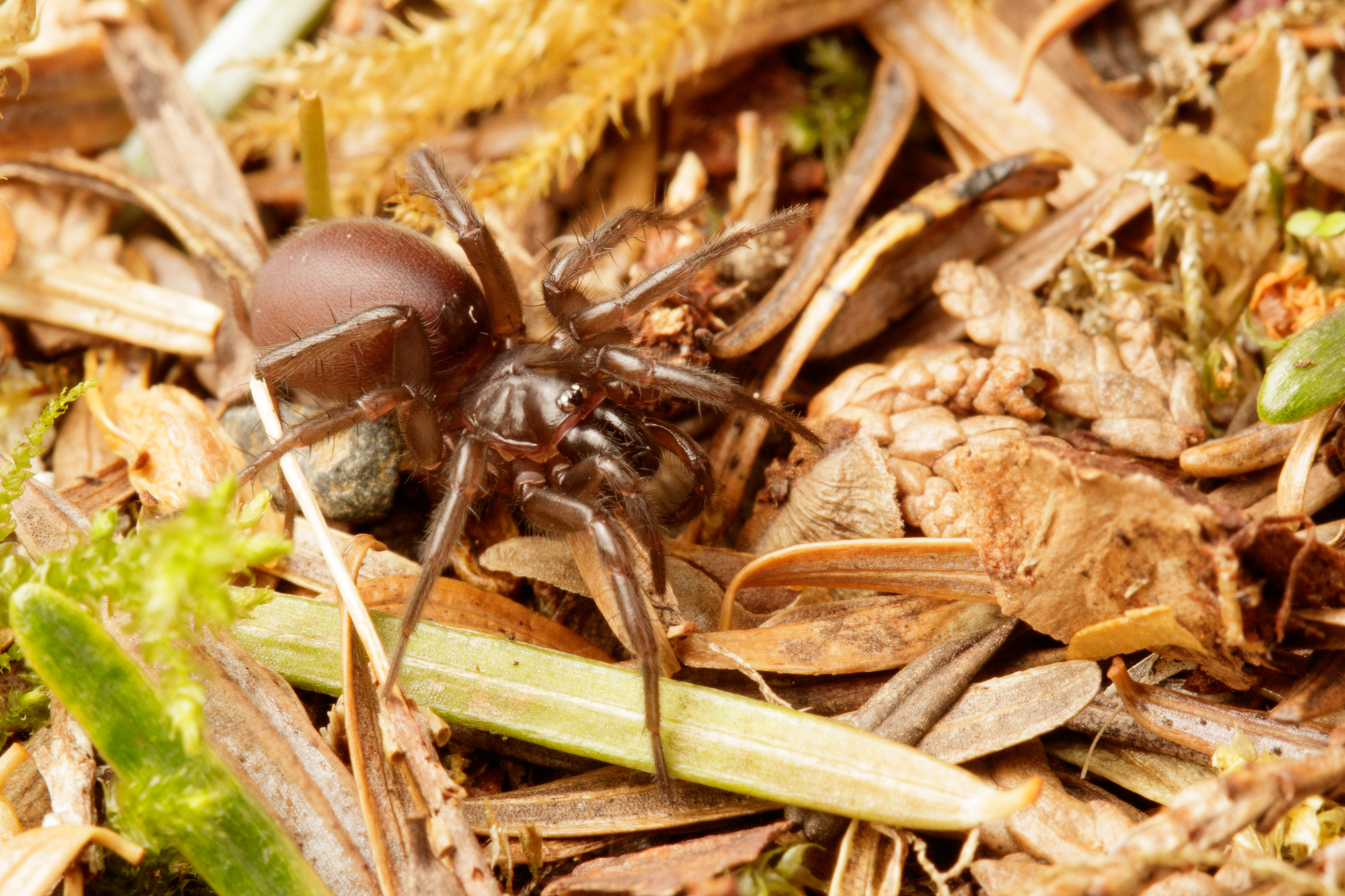 3. Hexura picea, a tarantula relative, brought out of its underground silk tunnel complex for a photo shoot.
3. Hexura picea, a tarantula relative, brought out of its underground silk tunnel complex for a photo shoot.These little, pretty, but nondescript spiders live in small silk tunnel complexes among the soil and rocks of the forest floor. Each tunnel has a main entrance lined with silk, and several other openings which may facilitate rapid escape or offer alternate exits at which to snare prey. Being members of the suborder Mygalomorphae, they are indeed tarantula relatives, a group of spiders that closely resemble ancient spiders. Many mygalomorphs retain traces of segmentation on their abdomens, unlike the more modern araneomorph spiders. In the Mecicobothriidae (to which Hexura belongs) the terminal spinneret segments bear “pseudosegmentation”
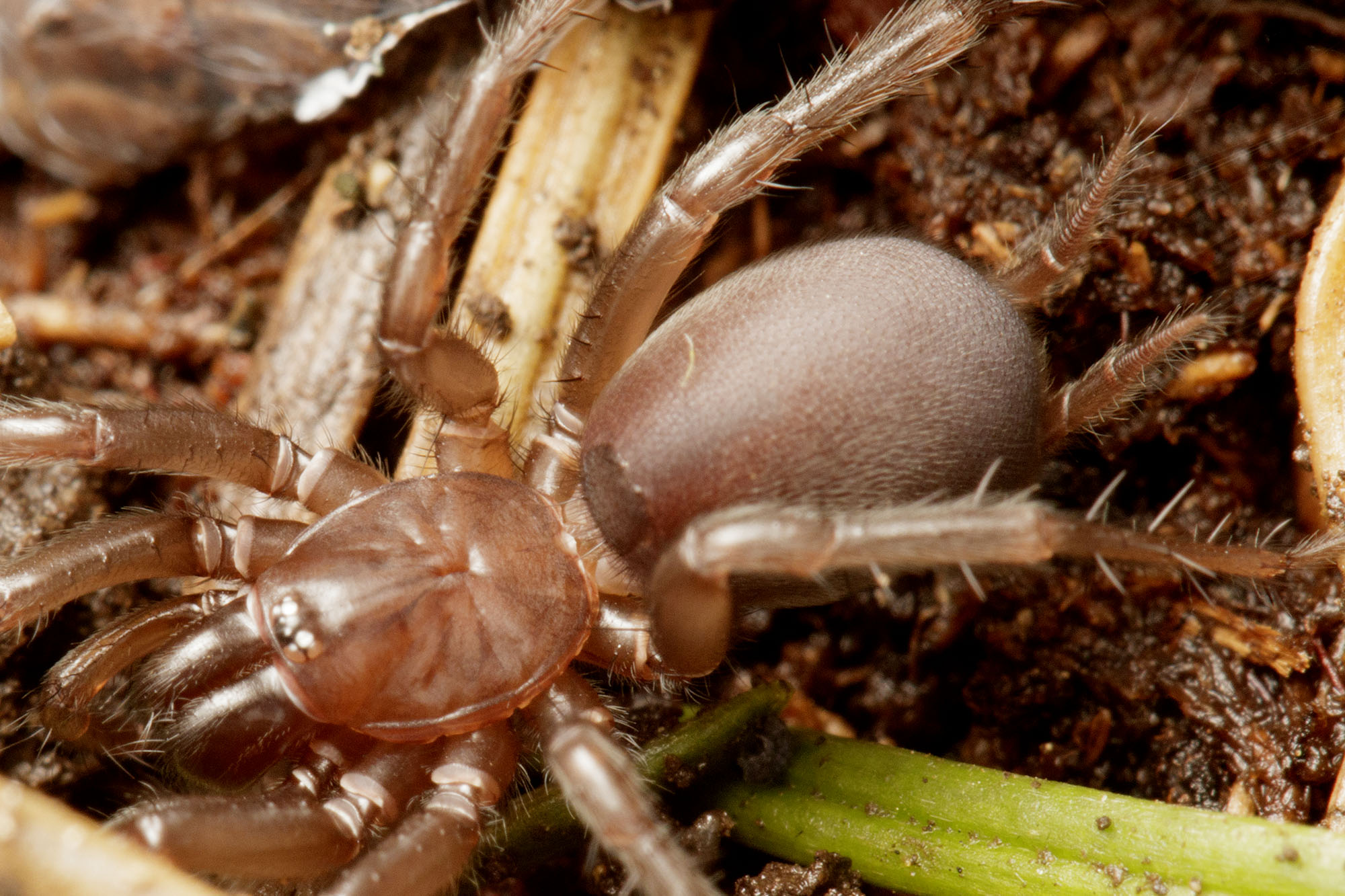
The section of forest we found this spider in was a real “tangled bank”, in fact the scree slope associated with Walbran creek and a small tributary, which has since been covered with a layer of soil and a stand of hardy trees.
 4. Erosion is a gentler process in a forested valley, with trees holding on to what would be a talus slope higher in the mountains. The soils beneath these trees support an extensive food web.
4. Erosion is a gentler process in a forested valley, with trees holding on to what would be a talus slope higher in the mountains. The soils beneath these trees support an extensive food web.Finding these spiders in the Walbran was not unexpected, as they had previously been found in the Carmanah Valley and at Avatar Grove, but their presence on Vancouver Island is somewhat puzzling, as they represent the only known Canadian population, and are seemingly not present on the BC mainland.
Given the dense population in the Walbran, the valley would be an wonderful place to study their behaviour, which so far is undocumented. We would presume that much of the activity of these spiders takes place at night, although Catherine was able to lure one out of its burrow by tickling the silken doormat with a twig.
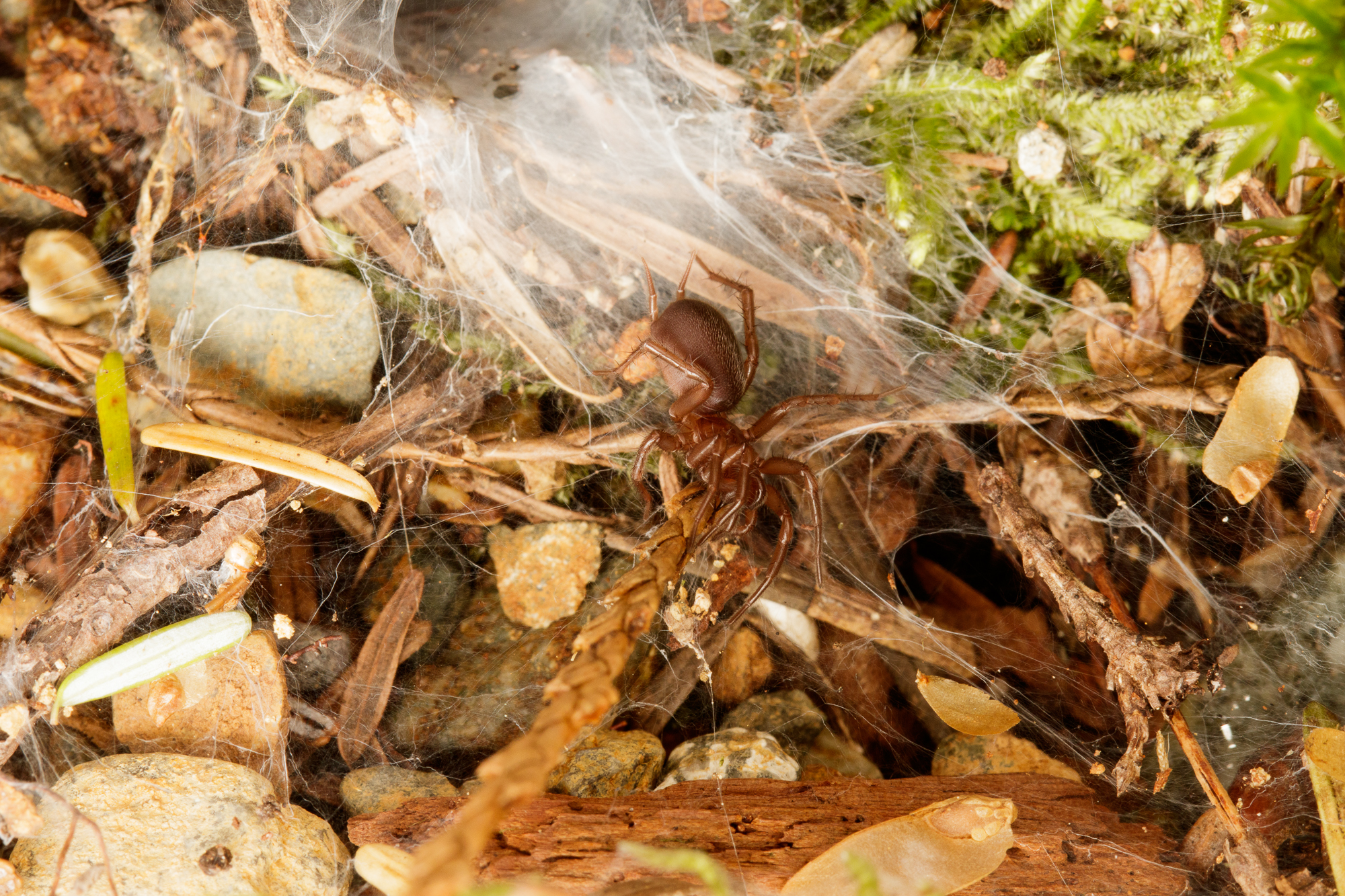 5. Hexura picea emerges from its silken tunnel and onto its “doormat” to “kill” a vibrating cedar twig.
5. Hexura picea emerges from its silken tunnel and onto its “doormat” to “kill” a vibrating cedar twig.The litter sampling we conducted will surely yield many more species, although we have to wait until the Berlese funnels have extracted all of the arthropods. The work of sampling and cataloguing biodiversity takes time, and is not totally congruent with the rapid “bioblitz” ethos.
If you are ever in BC, and want a trip back in time (never mind our politics), please do not hesitate to come out to the Walbran Valley. You may just discover something amazing.
 6. Darren and Claudia picking up pan traps beside the Malaise flight-intercept trap.
6. Darren and Claudia picking up pan traps beside the Malaise flight-intercept trap.

By Staffan Lindgren @bslindgren
Ever since childhood, I have been happiest crawling around turning over rocks, removing bark from stumps and inspecting every potential animal I can see. Early on, I was pretty much on my own, except for encouragement from my parents. At an early age, even before I reached teenage, I started joining various organizations that catered to likeminded geeks. Over the years, I have been involved in, or a member of literally dozens of such organizations. Central to my fascination has always been insects, and my dream was always to become an entomologist.
The first entomological society I joined was “Sveriges Entomologiska Förening” in Sweden. Because I grew up in a small northern town, I never really had the privilege of getting to know other members, and before I had much of a chance I was off to Canada. By then I had made some connections to Swedish entomologists through the professors, lecturers, and students of Umeå University, the Royal College of Forestry (now part of the Swedish University of Agricultural Sciences) and Uppsala University. I remained a member of SEF for some years, but once I knew that my planned return to Sweden was not going to happen, I gave that membership up in favour of the societies that I had joined and had closer connections with in North America. I have now been a member in good standing of the Entomological Society of Canada, ESBC, and ESA for more than 35 years, which is almost the entire time I have lived in Canada. I have served each of these societies in executive or other functions, most recently for four years on the executive of the ESC. Through these societies, I have gotten to know many colleagues who I now regard as friends as much as colleagues, I have established research collaborations, and gained a lot of knowledge that I would have missed by only reading what happened to be directly relevant to my own interests. In my opinion, I would not have had what little success I have enjoyed without my engagement in scientific society life.
Due to the unfortunate circumstances of my successor as President, I am currently Acting Past-President. One of my duties is to chair the Nominations Committee, which identifies individuals willing to put their name forward to serve on the ESC Governing Board (If you are interested in putting your name forward for 2nd Vice-President or Director-at-Large, PLEASE CONTACT ME!). In order to help me with this task, I requested a copy of the 2016 membership list. In going through the spreadsheet, I was rather disturbed at the absence of numerous individuals, some of whom have previously served important roles in promoting the ESC (you know who you are!). I know that it is easy to forget to pay the membership dues, but I have a feeling that the reasons for opting out are not always that simple. In the next week or so, memberships will expire, and it is time to once again contribute to your national and regional societies. I know that it seems like a lot of money, but if you think about it, we are talking about sums that are unlikely to break the bank of anyone. The ESC regular membership would be paid off by giving up about 60 cups of Tim Horton’s coffee or 30 cups of Starbucks special coffees. In other words, you would have to forego only about 2-3 cups of Starbucks per month to save enough. It may not seem that supporting the ESC gives you much in return, but if the society is not supported, it would mean that the Canadian Entomologist (one of the oldest journals in the world), the Bulletin, and the Annual meetings would cease to exist. That also means that opportunities to mix with likeminded geeks become more expensive and less frequent. That would be a shame, wouldn’t it?
Please, go to the computer right now and join or renew as a member of the ESC (and whatever Regional Society that is close to you). The ESC needs your support, and I believe you will benefit from being part of the national entomological family of Canada. For me, it has been a privilege to be part of one of the most welcoming and inclusive group of people in science. Please join me!


By Rama – Commons file, CC BY-SA 2.0 fr, https://commons.wikimedia.org/w/index.php?curid=53046764
Last winter, I spent a few months working on insect identifications for the BC Conservation Data Centre, mostly collections of insects made at newly-acquired conservation lands in the Okanagan and Kootenay regions of BC.
As I had no laboratory of my own, and no reference collections to work with, I was working out of the ROM, back behind Antonia Guidotti’s office in the entomology workroom. This place, in midwinter, is usually a little lonely, as Antonia has a lot of work to do all around the collection. And so mostly in solitude, I would sit there at my microscope, stumbling through insect IDs, learning what I could about a vast array of taxa, and listening to an inordinate amount of Leonard Cohen’s music.
Somehow, I feel the mood of Leonard Cohen’s later works lends itself so well to solitary entomology pursuits. The consummate outsider, looking closely and inwardly at the human condition, and yet always so aware of a wider world, Leonard’s music has many parallels to sitting at a scope, baffled by Nature’s diversity and wondering how it all fits together.
(As an aside, when I was going through scads of unfortunate, dead, trapped insects, the song « Who by Fire » seemed morbidly appropriate)
Occasionally, from the lab bench, I would reach out to the other folks online, sharing my discoveries through Twitter (the entomology workroom has a modest wireless connection!).
How excited I was, having lived in BC most my life to discover the wonderful piglet bug Bruchomorpha beameri, a wonderful fulgoroid planthopper that I had no idea even existed before taking this contract!
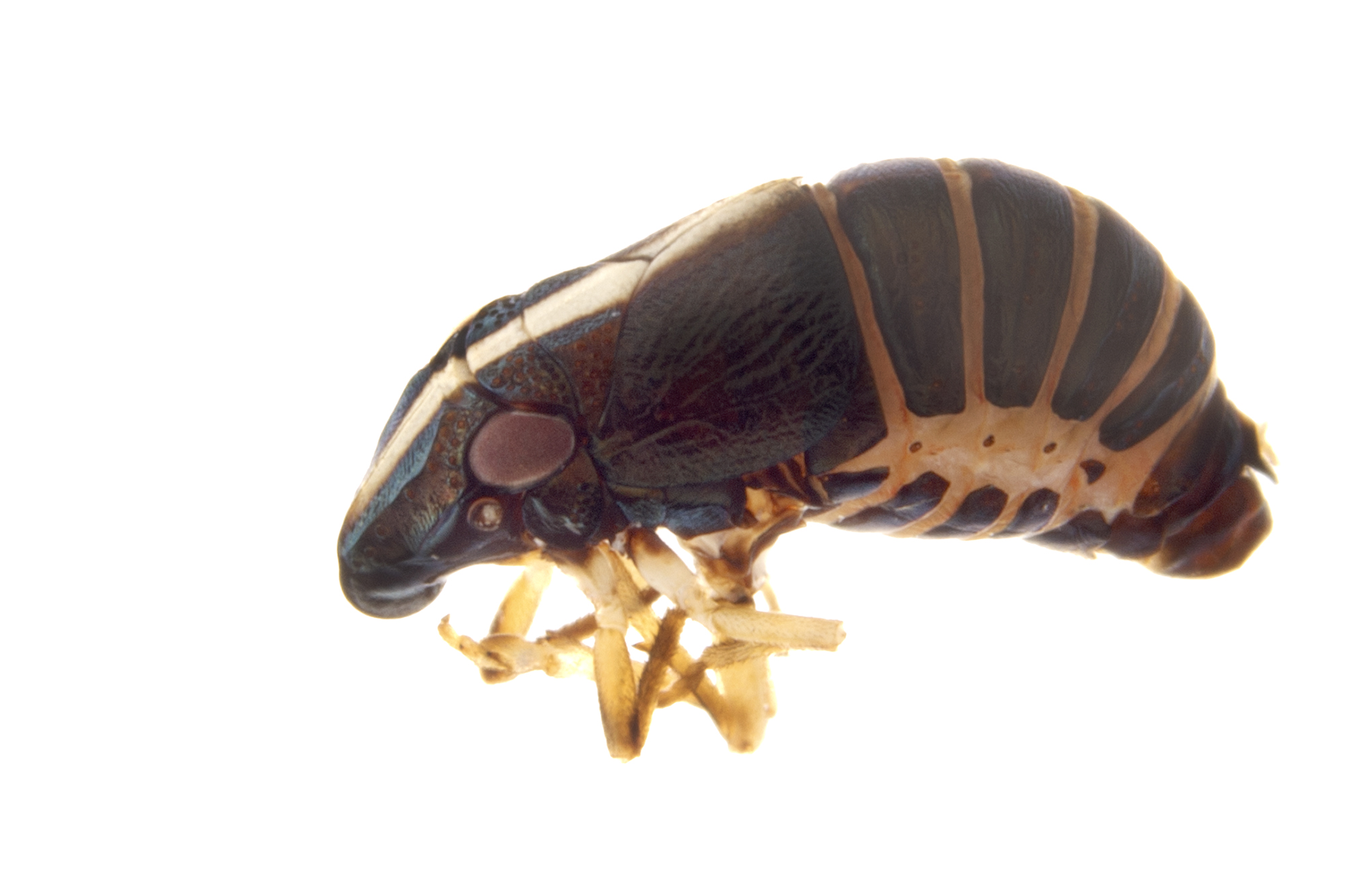
It was heartening, sitting there alone, singing softly along to Leonard Cohen that people out there on Twitter responded so well to my excitement at discovering these treasures, and offering helpful advice. Terry Wheeler was especially helpful when I was stumbling over some puzzling scathophagids from the Peace District.
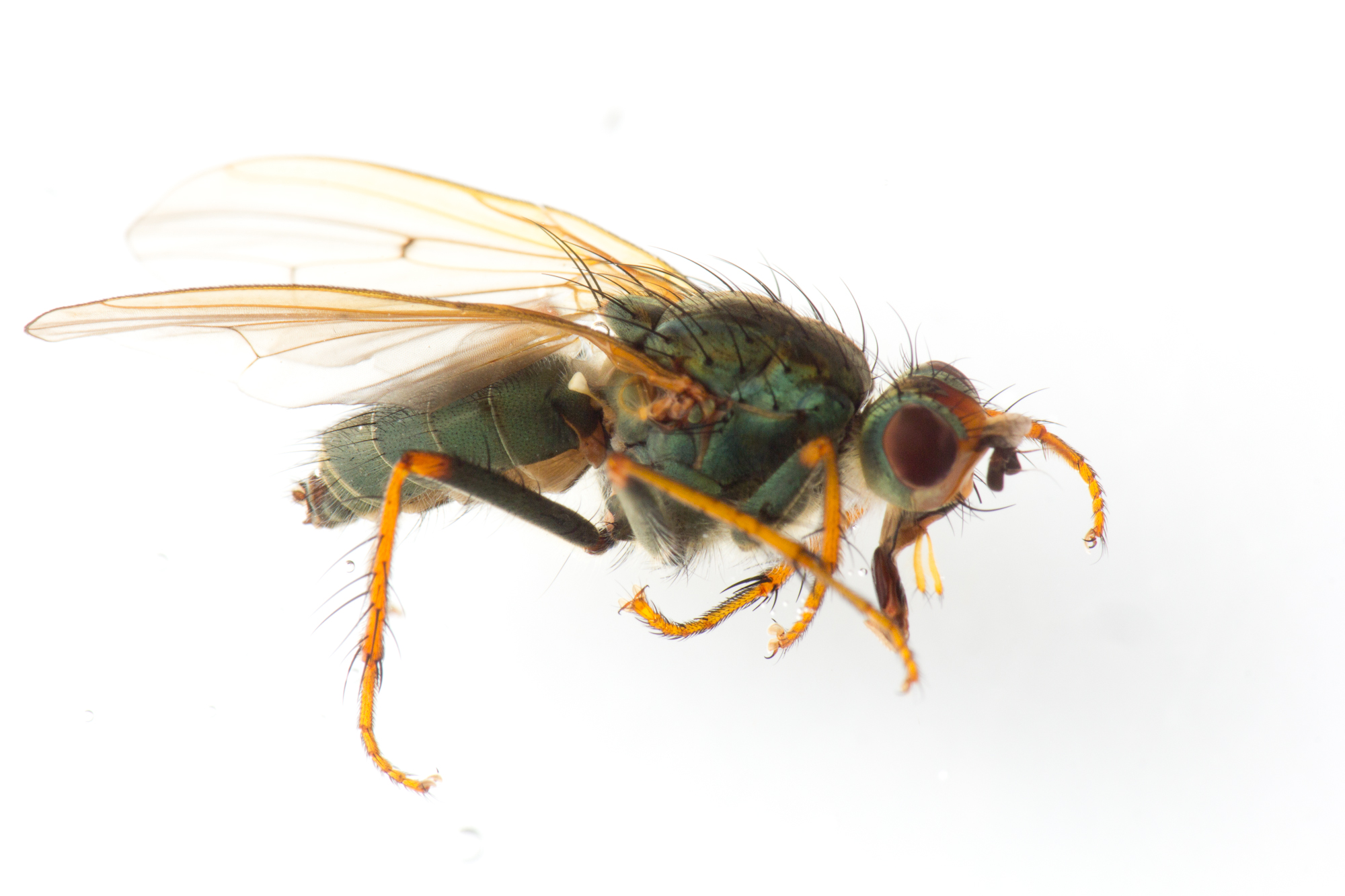
Connecting with people like Terry, who encouraged me through my ID struggles made me feel that despite being on the outer edges of my knowledge and what could reasonably be called paid employment in entomology, people cared about what I was doing and were there if I needed them.
With the help of Terry, Antonia, Laura Timms, Lu Musetti, and the great Leonard Cohen, I struggled my way through my contract, and my first eastern winter. Last week, Leonard Cohen died, leaving a huge hole in Canadian songwriting. We still have his recordings and poems to keep us company, though no matter what we are doing.
On Tuesday, I will head back to the ROM as a volunteer, to help sort out some of the ant collection, to the best of my ability. Perhaps I will listen to some of Leonard Cohen’s music, and tweet out some of what I find to connect me and my entomology work to the wider world.
[youtube https://www.youtube.com/watch?v=NW7oNpzBSGc&w=560&h=480]
© Copyright – Entomological Society of Canada
